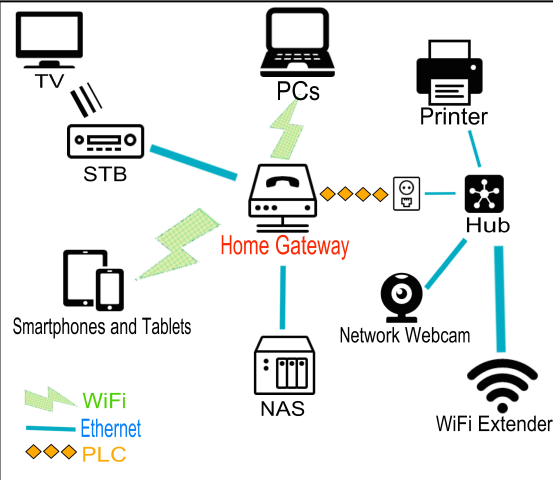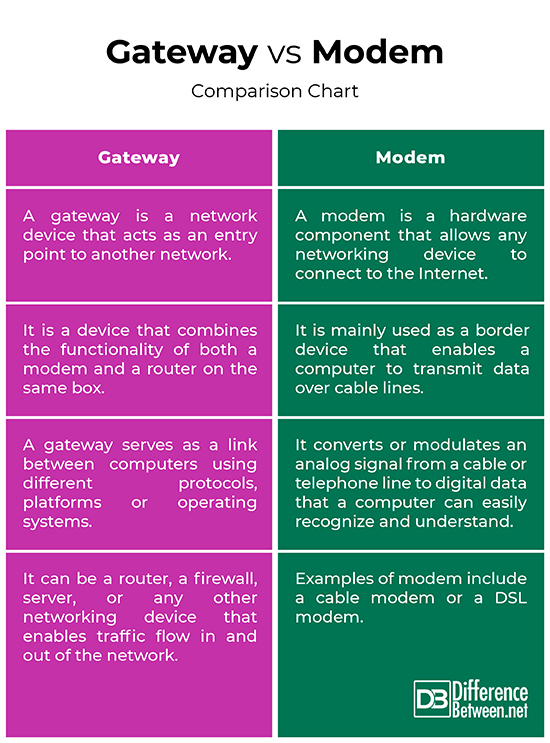Difference Between Gateway and Modem
Modem, stands for ‘modulator-demodulator,’ is a hardware device that allows a computer or any other networking device, such as a router, to connect to the Internet. The term ‘gateway’ has several meaning in the networking world, depending on the context. In general, a gateway is a networking device that connects two different networks together. It basically serves as a link between networks using different architectures, protocols or platforms.

What is Modem?
Short for ‘modulator-demodulator’, modem is a hardware device that acts as a LAN interface by connecting your home network to the ISP through the same coaxial cable that brings CATV signals to your television set. A modem is mainly used as a border device that enables a computer to transmit data over cable lines. The setup requires a splitter to separate the cable TV from the home network. Access to the Internet is typically provided by the cable TV service provider. Computer stores the information digitally whereas information transmitted over telephone lines is in the form of analog waves. It takes digital data from your computer’s Ethernet card and puts in an unused block of frequency. It’s like another TV channel, but instead of pictures and sounds, this channel carries digital data. Today, modems are used to make a high-speed broadband Internet connection from your home network to the ISP using the telephone line.

What is Gateway?
Gateway is a hardware device that functions both as a modem and a router by combining the functionality of both on the same box. Well, the term gateway has several meanings in the networking world. A gateway is a network point that acts as an entry point to another network. A gateway is a router interface connected to the local network in the sense it is a way out of a subnet or a connection point to a different subnet or network. In a broader sense, a gateway serves as a link between computers using different protocols, platforms or operating systems. The default gateway specifies where the data traffic is to be sent when the destination address is not in the same LAN or is unknown. It basically acts as a gate between two networks. It can be a router, a firewall, server, or any other networking device that enables traffic flow in and out of the network.
Difference between Gateway and Modem
Device
– A modem, short for modulator-demodulator, is a hardware device that connects to your cable or telephone line and converts or modulates an analog signal from a cable or telephone line to digital data that a computer can easily recognize and understand. It is simply a hardware component that allows any networking device to connect to the Internet. Gateway, on the other hand, is a device that combines the functionality of both a modem and a router on the same box. Generally speaking, a gateway is a network point that acts as an entry point to another network.
Function
– A modem is used to make a high-speed broadband Internet connection from your home network to the ISP using the telephone line. Phone lines are used for analog, voice signals. A modem is used with telephone line or cable to convert the data signals to those more compatible with the phone line capabilities. It transmits and receives data over a communication channel, such as telephone line, coaxial cable and optical fiber. A gateway, as the name suggests, acts as a gate between two networks, connecting multiple networks with different protocols together. It provides access for IP packets into and/or out of the local network.
Example
– A router is the best example of a gateway device commonly used in home networks which routes IP packets between networks. It allows computers within the local network to send and receive data over the Internet. A firewall also acts as a gateway that examines incoming and outgoing packets based on a set of defined rules in order to restrict suspicious packets. Examples of modem include a cable modem or a DSL modem. A cable modem allows broadband connection from your home network to the ISP over a cable connection. A DSL modem allows broadband access from your home network to the ISP over a telephone line.
Gateway vs. Modem: Comparison Chart

Summary of Gateway vs. Modem
A modem is a hardware device is mainly used as a border device that enables a computer to transmit data over cable lines. It converts the analog signal from a cable or telephone line into digital data that a computer can recognize and understand. A gateway, on the other hand, is a network device that acts as a gate between two networks; it serves as a link between computers using different protocols, operating systems or platforms. A gateway can be a router, firewall or server, or any other device that enables traffic flow in and out of the network. Gateway is just another term for a combined modem router.
- Difference Between Caucus and Primary - June 18, 2024
- Difference Between PPO and POS - May 30, 2024
- Difference Between RFID and NFC - May 28, 2024
Search DifferenceBetween.net :
Leave a Response
References :
[0]Dye, Mark A., at al. Network Fundamentals, CCNA Exploration Companion Guide. Noida, India: Pearson Education India, 2008. Print
[1]Dye, Mark A., at al. Network Fundamentals, CCNA Exploration Companion Guide. Noida, India: Pearson Education India, 2008. Print
[2]Beasley, Jesffrey S. and Piyasat Nilkaew. Networking Essentials, Third Edition. New York City, New York: Pearson Education, 2012. Print
[3]Shinder, Debra L. Computer Networking Essentials. Indianapolis, Indiana: CISCO Press, 2001. Print
[4]Bagad, Vilas and Iresh Dhotre. Computer Communication Networks. Pune, India: Technical Publications, 2006. Print
[5]Image credit: https://commons.wikimedia.org/wiki/File:Modem-and-router-units.jpg
[6]Image credit: https://upload.wikimedia.org/wikipedia/commons/thumb/e/ee/Home_gateway_example.png/553px-Home_gateway_example.png
